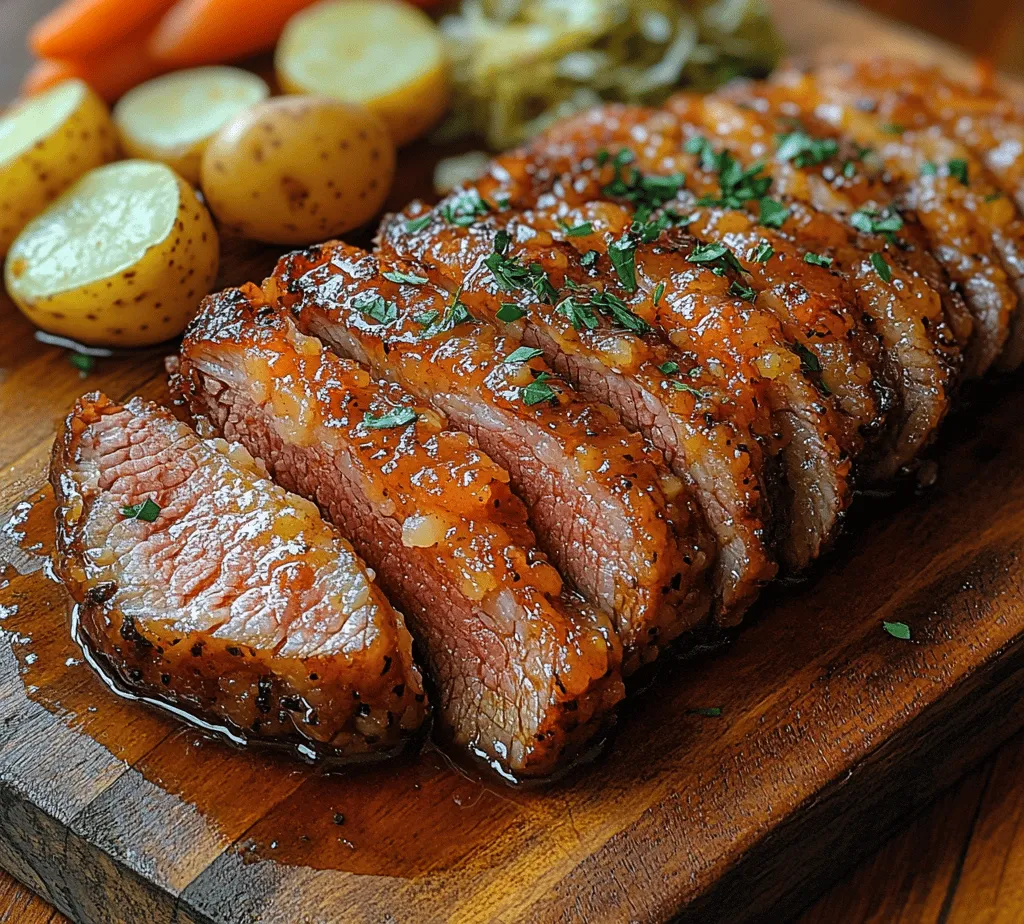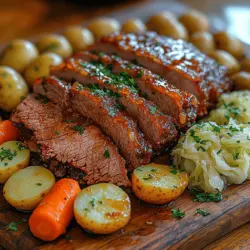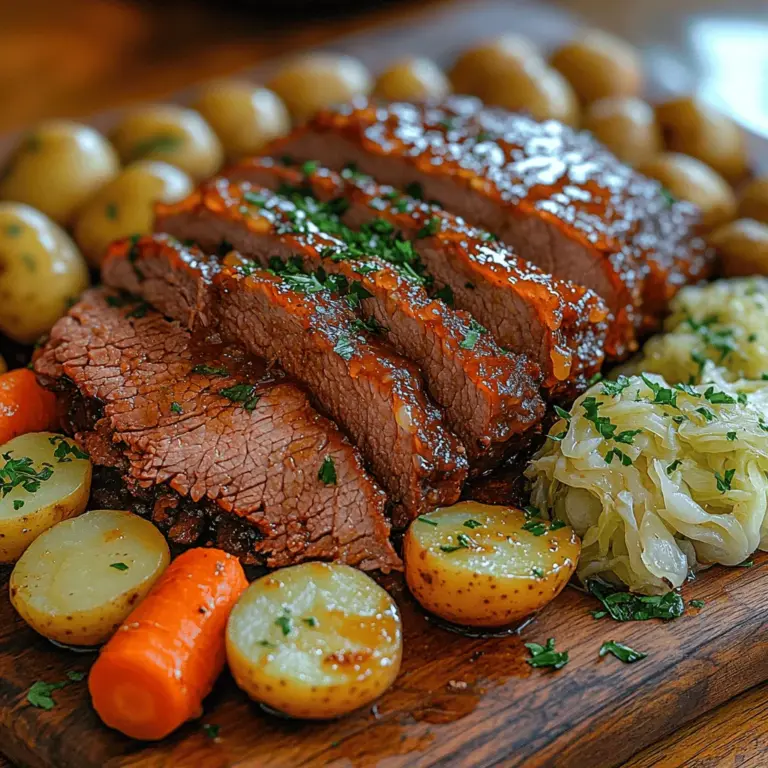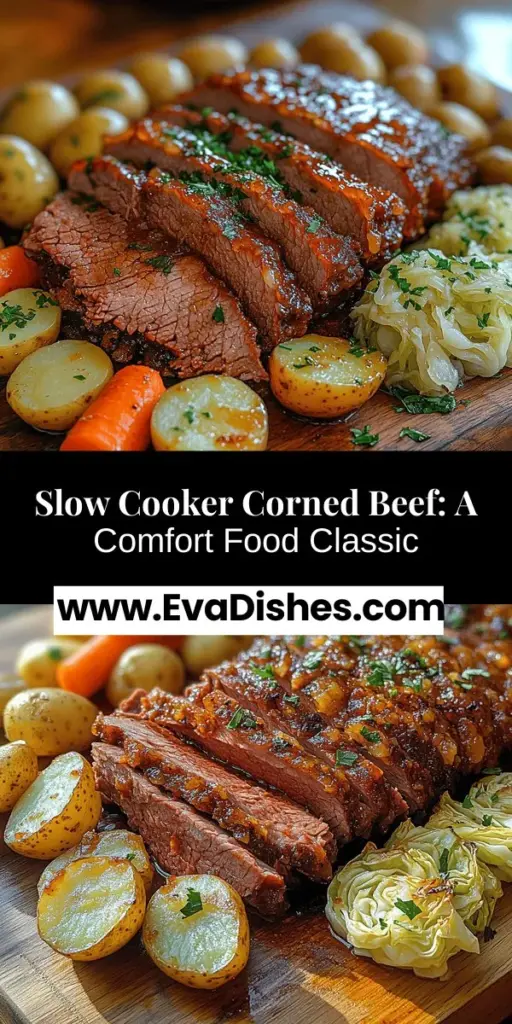Introduction
Corned beef has long been a staple of traditional comfort food, celebrated not only for its rich flavor but also for its tender texture. This beloved dish has roots in various cultures, particularly within Irish cuisine, where it is often associated with St. Patrick’s Day celebrations. However, corned beef is not just for special occasions; it is a versatile meal that brings warmth and satisfaction to family gatherings, holiday feasts, or even casual weeknight dinners.
One of the best methods to prepare corned beef is through a slow cooker, which allows for a gentle cooking process that enhances the flavors and ensures the meat remains tender and juicy. The slow cooking method provides an ideal environment for the spices and vegetables to meld together, creating a harmonious blend of tastes that elevates this classic dish. As the hours pass, the aroma fills your home, building anticipation for a meal that is both hearty and comforting.
In this article, we will guide you through the process of making tender and flavorful slow cooker corned beef, highlighting its appeal and offering tips and tricks to perfect your dish. Whether you are hosting a large family gathering or simply looking to enjoy a cozy meal at home, this recipe is sure to please everyone at the table.
Understanding Corned Beef
To fully appreciate the dish we are about to create, it’s essential to understand what corned beef is and its historical significance. Corned beef is made from beef brisket, which is cured in a brine solution that includes salt and spices. The term “corned” refers to the large grains of salt, known as “corns,” used in the curing process. This method not only preserves the meat but also infuses it with flavor.
Historically, corned beef became popular among Irish immigrants in the United States, particularly in the 19th century. It was often considered an affordable source of protein, making it a common choice for families. Today, corned beef is often associated with celebratory meals, especially during St. Patrick’s Day, where it is commonly served with cabbage and potatoes.
When purchasing corned beef, you will typically find a spice packet included with the brisket. This packet contains a blend of spices such as black peppercorns, mustard seeds, coriander, and allspice, which enhances the flavor of the meat. Understanding these spices and their role in the dish will help you appreciate the depth of flavor in your final meal.
Corned beef is not only delicious but also offers several nutritional benefits. It is an excellent source of protein, providing essential amino acids needed for muscle growth and repair. Additionally, the accompanying vegetables—such as carrots, potatoes, and cabbage—add fiber, vitamins, and minerals to the dish, making it a well-rounded meal.
Selecting the Right Ingredients
The success of your slow cooker corned beef largely depends on the quality of the ingredients you choose. Therefore, it is crucial to select the right components to ensure a flavorful and satisfying dish.
Key Ingredients
1. Corned Beef Brisket: The star of the show is, of course, the corned beef brisket. When shopping for this ingredient, look for a high-quality cut with a good balance of fat and meat. The fat helps keep the meat moist during cooking, while the brisket provides the rich flavor that corned beef is known for. Aim for a brisket that is well-cured and has a deep pink color, which indicates a good brining process.
2. Vegetables: Classic accompaniments for corned beef include baby carrots, potatoes, and cabbage. Each of these vegetables not only adds flavor but also contributes to the overall presentation of the dish.
– Baby Carrots: These tender, sweet carrots are perfect for slow cooking as they retain their shape and flavor. They add a lovely sweetness that balances the savory notes of the beef.
– Potatoes: Opt for waxy potatoes like red or Yukon gold. These varieties hold their shape well during the cooking process and absorb the delicious flavors from the broth.
– Cabbage: Traditionally, cabbage is served alongside corned beef, and incorporating it into the slow cooker allows it to soak up the savory juices, enhancing its flavor.
3. Broth and Aromatics: For the cooking liquid, using low-sodium beef broth is recommended. This allows you to control the saltiness of the dish, especially since the corned beef can be quite salty on its own. Adding fresh garlic and onions will elevate the flavor profile and create a robust base for the dish.
Importance of Quality
Using high-quality ingredients will not only enhance the flavor of your corned beef but also contribute to a more enjoyable eating experience. Fresh, crisp vegetables and a well-selected brisket will ensure that every bite is flavorful and satisfying. Take the time to source your ingredients from reputable suppliers or local markets, as this will make a noticeable difference in the final dish.
Preparation Steps for Perfect Corned Beef
Now that we have a clear understanding of the ingredients needed for our slow cooker corned beef, it’s time to dive into the preparation steps. Proper preparation is key to achieving a tender and flavorful result.
Step 1: Rinse the Corned Beef
Before you start cooking, it’s essential to rinse the corned beef brisket under cold running water. This step is important as it helps to remove excess salt from the curing process. While some salt is necessary to enhance the flavor, too much can overpower the dish. Rinsing the brisket also helps to eliminate any residual brine, ensuring a more balanced taste.
Step 2: Create the Flavorful Broth
Once the brisket has been rinsed, it’s time to prepare the broth. In a large bowl or measuring cup, combine the low-sodium beef broth with the spice packet that came with the corned beef. This mixture will serve as the cooking liquid in your slow cooker, providing the necessary moisture and flavor to the meat and vegetables.
You may also want to add additional aromatics to the broth, such as minced garlic and chopped onions. These ingredients will infuse the cooking liquid with extra flavor, enhancing the overall taste of the dish.
Step 3: Layer the Ingredients in the Slow Cooker
The way you layer your ingredients in the slow cooker is crucial to ensure even cooking. Start by placing the rinsed corned beef brisket at the bottom of the slow cooker. This allows the meat to absorb the full flavor of the broth as it cooks.
Next, add the chopped onions and minced garlic around the brisket, followed by the baby carrots and potatoes. Finally, place the cabbage on top. Layering the vegetables this way helps them cook evenly while allowing the flavors to meld together. The cabbage, being at the top, will steam beautifully as the dish cooks, soaking up the rich juices from the meat and broth.
Step 4: Pour in the Broth
Once all the ingredients are layered in the slow cooker, pour the prepared broth over the top. Ensure that the liquid covers the meat and vegetables adequately, as this will help them cook evenly.
Step 5: Set the Slow Cooker
With everything in place, secure the lid on your slow cooker and set it to low heat. Cooking corned beef on low for 8-10 hours allows the connective tissues in the meat to break down, resulting in a tender and flavorful dish. If you are short on time, you can set the cooker to high heat for about 4-6 hours, but the low setting is recommended for the best results.
By following these preparation steps, you are well on your way to creating a delicious and comforting meal that will please family and friends alike. The next part of our article will delve into further tips for achieving the best results and how to serve your slow cooker corned beef.

How to Arrange Vegetables and Aromatics for Optimal Flavor Infusion
When preparing your slow cooker corned beef, the arrangement of vegetables and aromatics plays a crucial role in enhancing the dish’s overall flavor. Start by layering your ingredients strategically. Place the denser vegetables, like potatoes and carrots, at the bottom of the slow cooker. This ensures they cook thoroughly and absorb the flavorful juices that seep down during the cooking process. Next, add aromatics such as bay leaves, peppercorns, and garlic cloves. These ingredients release their flavors slowly, creating a fragrant base for your corned beef.
On top of the vegetables, lay the corned beef brisket, fat side up. This positioning allows the fat to render down during cooking, basting the meat and ensuring it remains moist and tender. Finally, you can scatter some additional herbs, like thyme or parsley, on top for an extra layer of flavor that will infuse into the meat and vegetables as they cook.
Tips for Adjusting Ingredient Quantities Based on Serving Size
When preparing a meal like slow cooker corned beef, it’s essential to adjust your ingredient quantities based on how many people you plan to serve. As a general rule of thumb, plan for about 1/3 to 1/2 pound of corned beef per person. This means that for a gathering of four people, you should aim for a brisket weighing between 1.5 to 2 pounds.
If you decide to increase the size of your brisket, you may also want to increase the quantities of the vegetables accordingly. For every additional pound of corned beef, consider adding an extra potato and a couple more carrots. Keep the seasoning and liquid amounts proportionate as well. Maintaining this balance ensures that every bite is flavorful and well-seasoned, regardless of how many guests you have.
Cooking Process: Slow and Steady Wins the Race
The beauty of using a slow cooker lies in its ability to transform tougher cuts of meat, like corned beef, into tender, melt-in-your-mouth morsels. The slow cooking method allows collagen in the meat to break down gradually, resulting in a beautifully tender dish without the need for constant supervision.
For optimal results, set your slow cooker to low heat and cook the corned beef for 8 to 10 hours. If you’re short on time, you can opt for the high setting, which typically requires about 4 to 5 hours. However, slow cooking on low is recommended for the best flavor and texture.
As your corned beef cooks, keep an eye out for some key signs to determine when it’s perfectly done. The meat should be fork-tender, meaning you can easily pull it apart with a fork. Additionally, the internal temperature should reach at least 190°F for optimal tenderness. Using a meat thermometer can help ensure that your corned beef is cooked safely and to perfection.
Adding the Final Touch: Cabbage Preparation
Cabbage is a traditional accompaniment to corned beef, and it’s important to time its addition to the slow cooker correctly. About 1 to 1.5 hours before you anticipate the corned beef will be done, cut the cabbage into wedges and add it to the slow cooker. This timing prevents the cabbage from becoming too soft and mushy, allowing it to retain some crunch while absorbing the delicious flavors from the broth.
The addition of cabbage not only enhances the flavor profile of the dish but also boosts its nutritional value. Cabbage is rich in vitamins C and K, fiber, and antioxidants, making it a healthy complement to the hearty corned beef. Plus, its slight sweetness balances the savory, salty notes of the brisket, creating a well-rounded meal.
Serving Suggestions
When it’s time to serve your tender corned beef, proper slicing is key to maximizing texture and presentation. Always slice the corned beef against the grain, which means cutting perpendicular to the direction of the muscle fibers. This technique breaks up the fibers, resulting in more tender slices that are easier to chew. Aim for slices that are about 1/4 to 1/2 inch thick for the best experience.
To elevate your dish, consider garnishing the corned beef with fresh herbs, such as chopped parsley or dill. This adds a pop of color and freshness that brightens the overall dish.
For a complete meal, serve the corned beef and cabbage with sides that enhance the flavors. Traditional options include creamy horseradish sauce or mustard for dipping. You might also pair it with crusty bread to soak up the delicious juices from the slow cooker. For a heartier accompaniment, consider mashed potatoes or a side salad with a tangy vinaigrette to balance the richness of the corned beef.
Storing and Reheating Leftovers
If you happen to have leftovers (which is often the case with this hearty dish), proper storage and reheating methods are essential to maintaining the tenderness and flavor of your corned beef and vegetables. Allow the leftovers to cool completely before transferring them to an airtight container. Store the corned beef and vegetables together in the fridge for up to 3 to 4 days.
When it comes to reheating, the slow cooker is an excellent option, as it gently warms the meat without drying it out. Alternatively, you can use the stovetop. Place the corned beef in a skillet over medium heat, adding a splash of broth or water to keep it moist. Reheat until warmed through, stirring occasionally.
For those looking to repurpose leftovers, corned beef is incredibly versatile. Thinly slice the meat to make delicious sandwiches piled high with sauerkraut and Swiss cheese, or chop it up and toss it into a salad for added protein. You can also use it in a hash with potatoes and eggs for a satisfying breakfast option.
Conclusion
In summary, this tender and flavorful slow cooker corned beef recipe is an embodiment of comfort food that brings warmth and joy to any table. With its simple preparation and the slow cooking process, you can create a dish that is not only delicious but also a highlight of communal gatherings. Remember to adjust ingredient quantities based on your serving size, arrange your vegetables and aromatics thoughtfully, and take your time to achieve the perfect tenderness.
Sharing a meal made with love, like this slow cooker corned beef, creates lasting memories and fosters connection with family and friends. Don’t hesitate to experiment with variations of the recipe, such as adding different vegetables or spices, to make it uniquely yours. Embrace the comfort of this classic dish, and enjoy the delightful flavors it brings to your dining experience.


